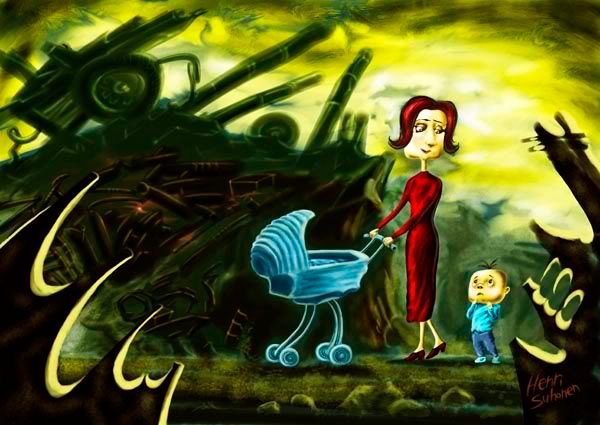 So, this attempt of a digital painting was recently posted on my site. While usually my ideas require a lot of planning, research and browsing through a ton of reference images, this is something that just 'popped' into my mind few months a go during a night when I was sleeping. I doodled a really quick sketch to my sketchbook (always keep one on your night-table!) before I would forget the thing.
So, this attempt of a digital painting was recently posted on my site. While usually my ideas require a lot of planning, research and browsing through a ton of reference images, this is something that just 'popped' into my mind few months a go during a night when I was sleeping. I doodled a really quick sketch to my sketchbook (always keep one on your night-table!) before I would forget the thing. Being still rather new to digital painting, the piece itself required some studuing on the technique. Hanging out at ConceptArt.Org forum (amazing site by the way, recommended) I found some great tutorial links at the critique center, such as these:
Being still rather new to digital painting, the piece itself required some studuing on the technique. Hanging out at ConceptArt.Org forum (amazing site by the way, recommended) I found some great tutorial links at the critique center, such as these:http://www.itchstudios.com/psg/art_tut.htm#top
http://www.itchy-animation.co.uk/light.htm
http://www.melissaclifton.com/tutorial-face.html
http://www.melissaclifton.com/tutorial-dino.html
 This is one of the first color versions. With the doodle turned to 'multiply', I added a greyish blue background (I read from the Imagine FX magazine that greyish blue and dull brown are usually the best background colors when starting a digital painting). From what I have learned from others, usually it is best to start painting the image in grayscale mode, low resolution, using burn and dodge tools for highligts, but I had such a strong vision for the colors that I started painting with colors in high resolution from the start. I painted all the colors roughly to their individual layers and then just used smudge tool to achieve a more subtle control, creating a contrasting Fallout 3 meets puppet animation style piece.
This is one of the first color versions. With the doodle turned to 'multiply', I added a greyish blue background (I read from the Imagine FX magazine that greyish blue and dull brown are usually the best background colors when starting a digital painting). From what I have learned from others, usually it is best to start painting the image in grayscale mode, low resolution, using burn and dodge tools for highligts, but I had such a strong vision for the colors that I started painting with colors in high resolution from the start. I painted all the colors roughly to their individual layers and then just used smudge tool to achieve a more subtle control, creating a contrasting Fallout 3 meets puppet animation style piece.However, when the image was seemingly finished, I checked the picture from other computer screens than my own. The image looked too light on any other screen. My screen has been carefully color-calibrated with i1match software and I use the recommended color profiles in Photoshop. This is a two edged sword; well-calibrated screen may produce right-looking works for the print environment, but they may not work in Internet environment because very few people use the same settings. When producing art for the web environment, all you can trust is what the Histogram says.

In this case, the image was too light because there weren't any pure blacks and pure whites as one can see from the histogram. My oil painting teacher used to tell that one should never use black to darken the colors (because black looks flat, not rich) but mix complementary colors to produce a darker color, but that does not work on digital painting. So, to make sure that the image would look good on at least most screens, I removed the marked gaps using levels panel and gave it the final pinch making an s-shape with curves panel and giving it a slight sharpening with unsharp mask filter.
Ei kommentteja:
Lähetä kommentti